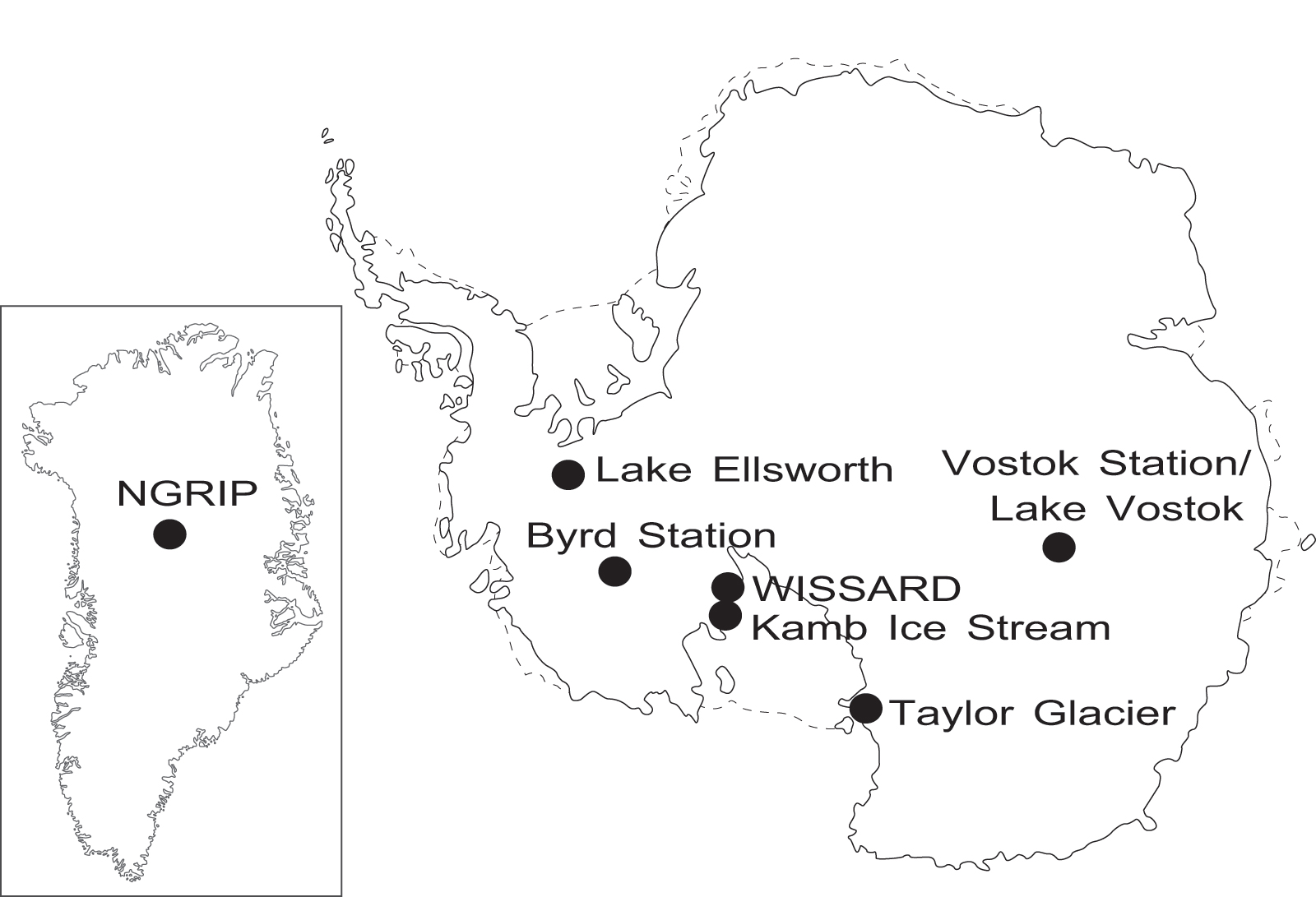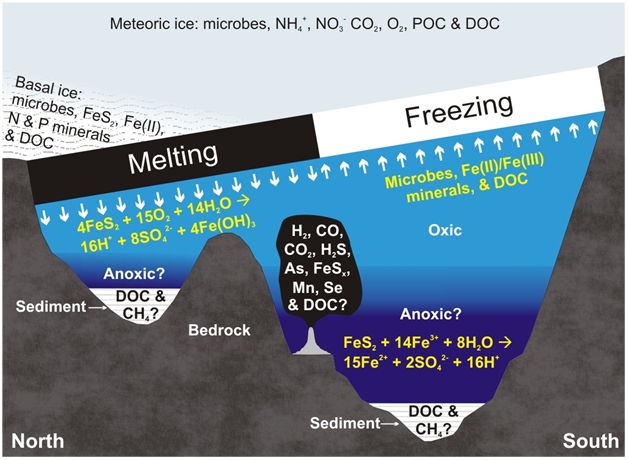
EXPLORATIONS FOR LIFE in Earth's deep terrestrial and oceanic subsurface have revealed an astonishing reality: most of the microbes on Earth exist deep within the planet's crust. Based on the data available, it has been estimated that 3.8-6.0 x 1030 microbial cells exist in the oceanic and terrestrial subsurface combined, and the subsurface could harbor a pool of carbon biomass that is 60-100% of that estimated for all plants. To provide some context, the total pool of microbes in the subsurface is approximately 20- and 50-times larger than the global inventory for the planet's soil and aquatic habitats, respectively. A number of outstanding questions remain regarding the nature of life in the subsurface, its connection to photosynthetic activity on the surface, the major redox processes fueling biochemical activity, and the contribution of these systems to global carbon budgets (to name just a few). Several reports have provided evidence for the presence of chemosynthetic microorganisms (i.e., microbes which derive their reducing agents and carbon from inorganic sources) in samples from the deep hot terrestrial subsurface, raising the possibility of ecosystems that operate independently of the photosynthetic world. The ramifications of this new vision for life on Earth cannot be overstated and have provided the proper perspective to determine the extent of our biosphere and extrapolate the distribution of life in the Solar System and beyond.
Research on microbial life in the subsurface is still in its infancy, and to date, most efforts have focused on the study of thermophilic (heat loving) microorganisms that have been described and characterized in samples retrieved from a variety of high temperature subsurface biomes (e.g., oceanic crust, aquifers, and gold mines). In contrast, virtually nothing is known about the diversity of microorganisms and range of habitable environments that exist beneath the planet's expansive ice sheets (>1.5 x 107 km2). In the 1960's, seismic data collected in the vicinity of Vostok Station and drilling at Byrd Station (Fig. 1) provided evidence that water is widespread at the ice sheet bed. In addition, basal water was encountered during drilling at NGRIP in Northern Greenland (Fig. 1), indicating that liquid water also exists at certain locations at the bed of the Greenland ice sheet and wet-based conditions may be more prevalent than previously thought. Despite extremely cold air temperatures above the ice, liquid water is stable in the basal zone of ice sheets owing to the combined effect of background geothermal heating, the insulating properties of the overlying ice sheet, and pressure induced lowering of the freezing point.
Microbiological investigations on deep portions of the Vostok Ice Core (i.e., the accretion ice) and sediments recovered from the base of the Kamb Ice Stream represent the only available data sets to provide context on the nature and distribution of life beneath the Antarctic ice sheets. Heterotrophic bacteria and fungi (i.e., microbes which use organic carbon as a reducing agent and carbon source) have been directly isolated from these samples and molecular analysis of DNA sequences extracted from the samples indicates that subglacial Antarctic environments are inhabited by at least 4 different bacterial phyla. Comparing the evolutionary relatedness of an environmental DNA sequence with closely related microbial species with known properties provides a basis to form hypotheses about the physiology of the source organism. In Subglacial Lake Vostok (Fig. 1), the recovery of DNA sequences most closely related to those of a hydrogen-utilizing thermophile has been used to argue that geothermal energy input from high-temperture mantle processes or tectonic activity may fuel a chemosynthetic community within the lake (Fig. 2). One commonality between some of the DNA sequences reported in Kamb Ice Stream sediments, Subglacial Lake Vostok accretion ice, and subglacial outflow from the Taylor Glacier (Fig. 1) are a close relation to species with metabolic lifestyles that revolve around iron and/or sulfur respiration or oxidation. The erosion of bedrock via glacial processes liberates crushed sulfide and iron minerals from the bedrock, where they are subject to chemical and/or biological weathering reactions (Fig. 2). A key point about the latter mechanism is that the physical action of ice and bedrock is all that is necessary to supply the energy for a chemosynthetically-based ecosystem.

Liquid water is abundant beneath the West and East Antarctic ice sheets, with subglacial lakes containing ~10,000 km3 of liquid water (for comparison, Lake Superior contains 12,000 km3 of water). Assuming a subglacial aquifer extent of at least 1 km, the total volume of groundwater beneath the Antarctic ice sheets is estimated at ~107 km3. Based on available data from the ice and sediments (see above), the subglacial environment of Antarctica may harbor ~1029 prokaryotic cells, which equates to ~4.4 gigatons of cell carbon and is about 20% of that reported for the surface soils on Earth. In terms of dissolved organic carbon (DOC), the Antarctic ice sheets and subglacial aquifer are estimated to contain 10 gigatons of DOC, which is nearly 20-fold higher than values in all the planet's surface freshwater ecosystems. Clearly these estimates are tentative and should be revised when new data are available. However, they do indicate that Antarctic ice and its associated subglacial aquifer system contains a globally relevant yet virtually ignored pool of microbes and carbon, which should be considered when addressing issues concerning global carbon dynamics.
The technological and logistical issues, together with concerns for environmental protection, make subglacial lake environments challenging systems for scientific study. Despite these challenges, 3 pioneering projects are currently underway to drill into and sample subglacial aquatic environments beneath the ice sheet in East and West Antarctica.
Funded by the Antarctic Integrated System Science Program of NSF's Office of Polar Programs, Antarctic Division, the objective of the Whillans Ice Stream Subglacial Access Research Drilling project (WISSARD; http://wissard.org/) is to assess the role of water beneath a West Antarctic ice stream (Fig. 1) and associated ice shelf in interlinked glaciological, geological, microbiological, geochemical, hydrological and oceanographic systems. WISSARD is a 6-year project (2009-2015) and represents an unprecedented opportunity to make direct observations and analyze basal ice, subglacial water, and sediments to address fundamental scientific questions pertaining to: (1) past and future marine ice sheet (in)stability, (2) subglacial hydrologic and sedimentary dynamics; (3) subglacial metabolic and phylogenetic biodiversity; and (4) the biogeochemical transformation of major nutrients within a selected subglacial environment.
At Vostok Station, a project funded by the Russian Federal Service for Hydrometeorology and Environmental Monitoring reinstated drilling in the 5G borehole during 2006, and currently, are ~150 m from entering Subglacial Lake Vostok. The current plan is to replace the kerosene-based fluid in the bottom of the borehole with silicone oil prior to penetrating the lake with a thermal drill, which is scheduled to occur during the 2011/12 season. Lake water entering the borehole will eventually freeze and this material will be drilled and recovered for analysis during a subsequent field season. More information on the water sampling plan is available at the Russian Antarctic Expedition web site (http://www.aari.aq/).
A collaboration of scientists in the United Kingdom is also preparing to drill into a subglacial lake in West Antarctica, named Subglacial Lake Ellsworth (Fig. 1; see http://www.geos.ed.ac.uk/research/ellsworth/). As in the WISSARD project, the team will enter the lake by hot water drilling through the overlying 3400 m of ice, lower an instrument probe to measure the biological, chemical and physical characteristics of the lake water and sediments, and then return water and sediment samples to the surface for analysis. Direct access, measurement and sampling of Subglacial Lake Ellsworth is planned for the 2012-13 Antarctic field season.
Subglacial environments remain one of the last unexplored frontiers on our planet and efforts to explore these systems will be at the forefront of cryospheric research in the future. The presence of viable microbial life in deep regions of the cryosphere and realization that large quantities of liquid water and biomass exist beneath the World's ice sheets has changed the way biologists think about life in the polar regions. In the not too recent past, the ice-covered regions of Antarctica and Greenland were viewed as environments with conditions too extreme to support life. That view has changed in the last decade as evidence has accumulated which supports the view of the subglacial environment as an oasis for life in the polar regions. The efforts to enter, sample, and explore the subglacial aquatic environments of Antarctica are sure to contribute to our understanding of the physical, chemical and biological processes operating beneath the ice sheet. The years to follow should prove to be an interesting and unique time of discovery in Antarctic research.
Further reading: Christner, B.C., M.L. Skidmore, J.C. Priscu, M. Tranter, and C.M. Foreman (2008) Bacteria in subglacial environments. In R. Margesin, F. Schinner, J.-C. Marx, and C. Gerday (eds), Psychrophiles: From Biodiversity to Biotechology. Springer, New York.
